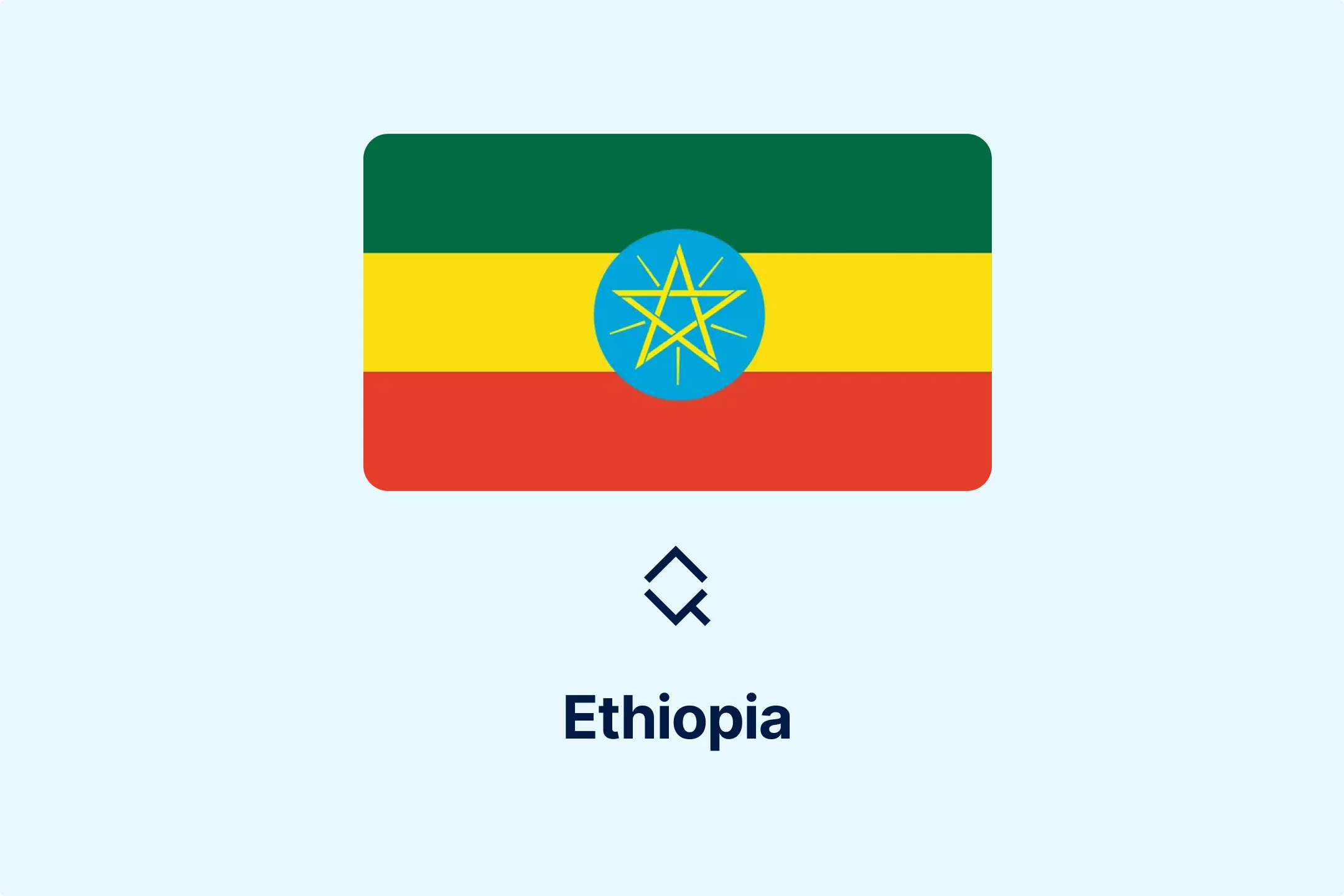Réformes de la TVA numérique en Éthiopie : Principaux changements et implications

Introduction
Dans une démarche audacieuse visant à moderniser son système fiscal et à capter les revenus de l'économie numérique, l'Éthiopie a adopté des changements radicaux à son régime de taxe sur la valeur ajoutée (TVA). La pièce maîtresse de cette réforme est la proclamation n° 1341/2024, promulguée en juillet 2024, qui abroge l'ancienne loi sur la TVA en vertu de la proclamation n° 285/2002. Parmi les changements les plus significatifs, l'extension des obligations de TVA aux fournisseurs non-résidents de services et de plateformes numériques, suivant le modèle de plus en plus adopté à travers l'Afrique de l'Est.
1. Cadre juridique et objectifs politiques
Le cadre de la TVA numérique est établi par la Proclamation sur la TVA n° 1341/2024, et les règlements d'application sont attendus. Ces règles marquent une amélioration substantielle de l'assiette fiscale de l'Éthiopie en ciblant la fourniture de services numériques depuis l'étranger et en renforçant l'architecture d'application du pays grâce à une combinaison de critères d'enregistrement, de déclaration et de critères basés sur la technologie.
Les principaux objectifs politiques sont les suivants
Taxer l'économie numérique de manière équitable et efficace.
S'aligner sur les orientations de l'OCDE en matière de TVA numériqueet sur les pratiques adoptées dans la région de l'Afrique de l'Est.
Augmenter les recettes de TVA et freiner l'érosion de la base d'imposition due au commerce électronique transfrontalier et à la consommation numérique.
2. Champ d'application de la TVA sur les services numériques
a) Extension aux fournisseurs de services numériques non résidents
À partir d'août 2024, l'Éthiopie a commencé à exiger que les fournisseurs non-résidents de services électroniques s'enregistrent et déclarent la TVA lorsqu'ils fournissent des services aux consommateurs éthiopiens. Cela inclut les entreprises étrangères qui offrent
de la vidéo et de la musique en streaming
des services d'hébergement et d'informatique en nuage
des téléchargements et des mises à jour de logiciels
des plateformes d'apprentissage en ligne
des services de publicité et des places de marché en ligne.
b) Plateformes numériques et responsabilité des places de marché
Les places de marché et les opérateurs de plateformes sont considérés comme des fournisseurs présumés lorsqu'ils facilitent la vente de services numériques aux consommateurs locaux. Les plateformes numériques (par exemple, les magasins d'applications, les sites d'apprentissage en ligne) sont considérées comme des "fournisseurs présumés" si elles :
- autorisent les paiements
- Fixent les conditions de fourniture.
- Facilitent la livraison
c) Transactions B2B vs. B2C
Les transactions B2C sont soumises à une TVA de 15 %, tandis que les transactions B2B suivent un mécanisme d'autoliquidation, dans lequel l'entreprise éthiopienne comptabilise elle-même la TVA.
3. Enregistrement, seuils et dépôt
a) Seuil d'enregistrement de la TVA
Un seuil d'enregistrement de 2 millions ETB par an (environ 16 800 USD) a été fixé pour les fournisseurs résidents et non-résidents. Une fois ce seuil dépassé, le fournisseur doit
s'enregistrer auprès du ministère éthiopien des revenus et de l'autorité douanière
facturer une TVA de 15 % sur les services numériques applicables
Déclarer la TVA et la reverser.
Le seuil est relativement bas par rapport aux pays voisins, ce qui garantit une large couverture des fournisseurs internationaux de taille moyenne.
b) Enregistrement numérique simplifié
Pour les entreprises non-résidentes, un portail d'enregistrement simplifié devrait être mis en place pour faciliter la conformité à distance. Les réglementations à venir sont susceptibles d'inclure des mécanismes de dépôt flexibles et d'autoriser le recours à des agents ou intermédiaires fiscaux en Éthiopie.
c) Facturation de la TVA
La proclamation stipule que les contribuables sont tenus d'émettre des factures conformes à la TVA. Toutefois, les exigences en matière de facturation seront définies dans les futurs règlements.
4. Détermination du lieu de prestation
Pour déterminer si l'Éthiopie est le lieu de prestation et donc le lieu d'imposition de la TVA, le projet de règlement propose d'utiliser une combinaison d'identifiants numériques. Il s'agit notamment des éléments suivants
les coordonnées bancaires ou de paiement associées à l'Éthiopie
une connexion internet fixe située en Éthiopie
Carte SIM de téléphone portable ou code pays lié à l'Éthiopie
l'adresse IP indiquant la localisation en Éthiopie.
Cette approche est conforme aux normes internationales en matière de règles de TVA sur les services numériques à distance, ce qui renforce l'applicabilité de la TVA éthiopienne sur les fournisseurs numériques étrangers.
5. Le paysage général de la TVA en Éthiopie
Bien que les mesures relatives à la TVA numérique soient nouvelles, elles s'inscrivent dans le cadre plus large de la TVA en Éthiopie, qui conserve plusieurs caractéristiques traditionnelles :
a) Taux et structure de la TVA
Taux de TVA standard: 15 % s'applique à la fourniture de biens et de services en Éthiopie : La fourniture de biens et de services en Éthiopie, y compris les importations.
Taux zéro: Exportations et services rendus en dehors de l'Éthiopie
Exonéré: Les produits alimentaires de base, les services médicaux et éducatifs, les services financiers et certains produits agricoles.
b) Déduction de la TVA en amont
Les entreprises enregistrées peuvent déduire la TVA payée en amont sur les achats directement liés aux fournitures imposables. Si la TVA en amont dépasse la TVA en aval, le crédit peut être reporté ou faire l'objet d'une demande de remboursement (sous réserve de certaines conditions).
6. Technologie et infrastructure administrative
Pour soutenir la mise en œuvre de ces réformes, l'Éthiopie investit dans la numérisation de la fiscalité :
Le système intégré d'administration fiscale (ITAS) remplace l'ancienne plateforme SIG-TAX, introduisant :
l'enregistrement numérique des contribuables et le dépôt des déclarations
l'amélioration de l'analyse des données et du profilage des contribuables
l'intégration avec les systèmes douaniers et fiscaux.
Conclusion
La réforme de la TVA numérique en Éthiopie est une étape importante dans le processus de modernisation fiscale du pays. En taxant les fournisseurs non-résidents et les places de marché, en introduisant des identifiants numériques pour déterminer le lieu de livraison et en tirant parti de la technologie grâce aux intégrations ITAS et Fayda, le gouvernement avance de manière décisive vers un régime de TVA plus équitable et plus efficace.
La réforme s'aligne sur les principes internationaux de la TVA et vise à améliorer la conformité, à renforcer la neutralité fiscale et à accroître la mobilisation des recettes nationales dans un environnement numérique qui évolue rapidement. Les réglementations finales seront essentielles pour façonner la prochaine phase de mise en œuvre, mais la direction est claire : l'Éthiopie s'aligne sur les pratiques mondiales en matière de TVA numérique et construit un cadre qui garantit l'équité et la conformité transfrontalières dans une économie de plus en plus numérique.
Source : Ethio Alliance, Proclamation sur la taxe sur la valeur ajoutée 1341/2024

Articles en vedette

Angola’s E-Invoicing Mandate: Phased Implementation Continues Into 2026
🕝 December 10, 2025
Déduction de la TVA et succession d'entreprise : Quand les frais de conseil servent-ils les intérêts de l'entreprise ?
🕝 December 8, 2025
Le changement de fiscalité du plastique en Europe : Pourquoi la taxe italienne sur le plastique commence en 2027
🕝 December 3, 2025
Le déclin des exonérations d'importations de faible valeur : Combler les lacunes du commerce électronique transfrontalier
🕝 November 20, 2025Plus de nouvelles de Éthiopie
Obtenez des mises à jour en temps réel et des informations sur l'évolution de la situation dans le monde entier, afin d'être informé et préparé.
-e9lcpxl5nq.webp)


